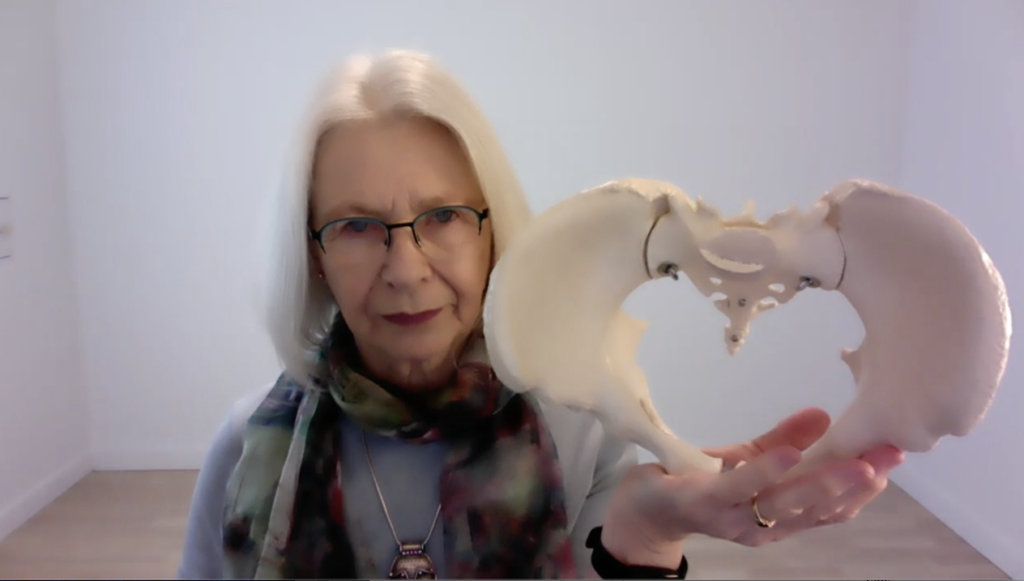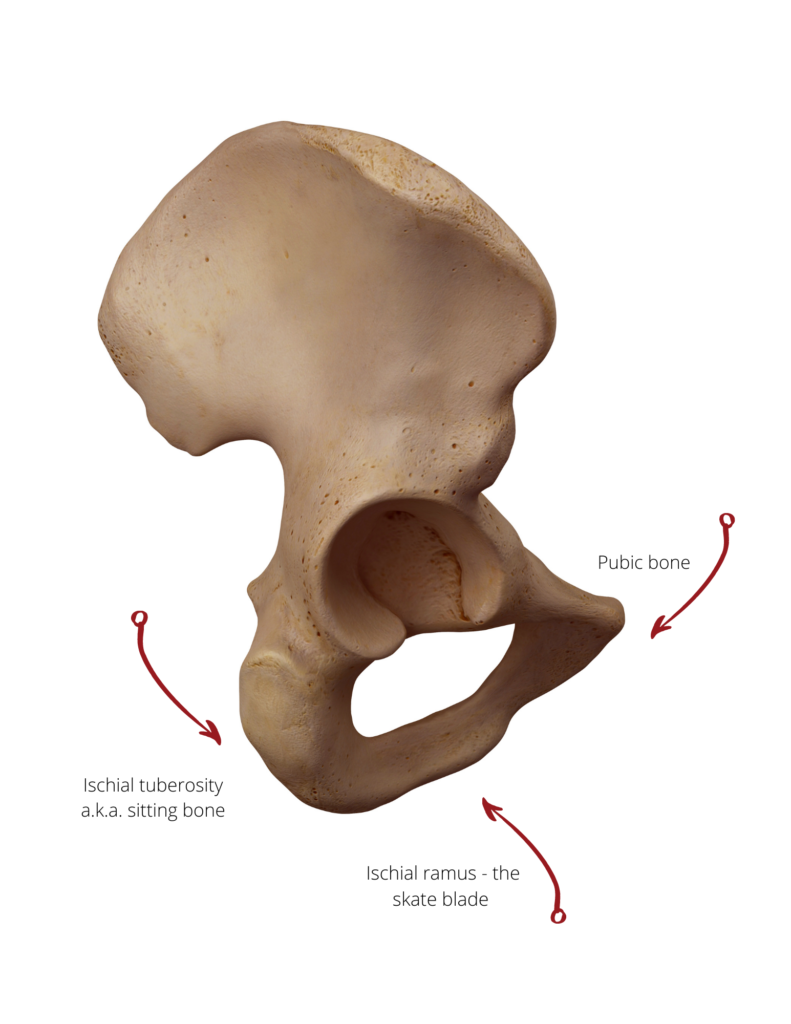Sitting bone pain: are you sitting on the wrong bones?

Most of the time, we are not aware of how we sit. Sometimes we follow a cue in a yoga class, such as, “sit on the ball points of the sitting bones,” or “sit with the pubic bone parallel to the wall in front of you.” In the case of both those cues, you will end up on your ischial tuberosities.
In fact, everyone from your yoga teacher to your physiotherapist will tell you to sit on your ischial tuberosities, a.k.a. your “sitting bones.”
The argument goes like this: the ischial tuberosities are called the sitting bones, so you should sit there.
But if you google “sitting bone pain” you will be rewarded with 76,900,000 hits. While that number is dwarfed by more popular maladies – elbow pain brings up 336 million, for example – it still suggests there might be something wrong with this advice.
If, on the other hand, you google “Noelle Perez Aplomb,” the person, Noelle Perez, and the body of work, Aplomb/Balance/Spinefulness, that offers a real solution to sitting bone pain, you’ll get 319,000 hits.
My goal here is to see if we can begin to change the numbers: more people living in alignment with gravity, less sitting bone pain.
To begin, just because our culture promotes sitting on our sitting bones, that doesn’t mean that they’re the best place to sit.
As you may remember your mother saying: “If all your friends were going to jump off a cliff, would you do that too?”
We do, of course, have to sit on some part of our pelvis. In the simplest of senses, the pelvis is our sitting bone. But the pelvis is a large and complex structure, and there is more than one possible perch.
 The image above is a side view of the pelvis. The top rim is what you feel when you put your hand on your hip bone, just below your waist. The shape that looks like an incomplete donut is your hip socket. The ischial tuberosities are out back.
The image above is a side view of the pelvis. The top rim is what you feel when you put your hand on your hip bone, just below your waist. The shape that looks like an incomplete donut is your hip socket. The ischial tuberosities are out back.
The ischial ramus, the stretch of bone that looks a bit like a skate blade is roughly in the middle. And at the front is the pubic bone. They both function better as a spot to sit than the “sitting bones.”
For example: one common cause of sitting bone pain is ischial bursitis. The small fluid-filled sacs, called bursa, that act as a cushion between bones and tendons become inflamed. Suddenly, sitting is painful, and the pain increases the longer you sit. Sometimes overdoing running or cycling causes ischial bursitis. More commonly, it comes from perching on your sitting bones on a hard surface for too long. You can get cortisone shots if the pain persists, but there’s an easier and less invasive first alternative.
Bob and Brad, the charming upbeat duo whose theme song proclaims them to be “the most famous physiotherapists on the internet,” have a detailed video on how to stop sit bone pain from ischial bursitis and from hamstring injuries.
Brad folds a pillow and sits on a chair with his ischial tuberosities behind the pillow, and the weight of his pelvis falling forward. When Bob demonstrates what that looks like with a skeletal model on the pillow, at about the four-minute mark, you can see the pubic bone facing directly down.
Sitting this way takes pressure off the bursa and promotes healing. It also raises a question: if moving weight off the ischial tuberosities toward the pubic bone relieves pain, might it not prevent the condition in the first place?
In addition, when you sit forward of the “sitting bones” towards the public bone, your sacrum moves closer to its optimum position to receive the weight of your spine. Suddenly you have more ability to sit with a long, relaxed spine. Or as Brad notes when he demonstrates sitting on the blanket: “it puts you into better posture, too.”
So, if sitting forward of your sitting bones removes pain and improves your posture, why not sit there all the time?
This is, by the way, Noelle’s Perez’s key insight, that the pelvis in natural balance is rotated forward. The pubic bones face the floor, and when we’re standing or sitting, the sacrum balances over the pubic bones.
There’s an easy way to check this out. Placed on its pubic bones, a model of the pelvis will balance on the palm on your hand. If you try to balance it on its sitting bones, it will topple backwards. Check out my video to see this in action. link
Slanting the top of the pelvis back, as we do when we sit on the “sitting bones,” takes us out of this natural balance. The result is a cascade of disasters. Among them: tipping back on your pelvis increases instability at the SI joint (where the sacrum meets the ilium). That in itself can be a source of sitting bone pain.
In the past 50 years, Noelle Perez and her students have researched the posture of people around the world in places where back pain from faulty posture is rare to nonexistent. In all of these societies, from a Portuguese fishing village, to villages in Senegal, Bali and Papua New Guinea, people live with their pelvis rotated forward and their spine relaxed.
Meanwhile, in urban settings the world over, healthy toddlers have this same pelvic alignment until about the age of three. They accumulate plenty of “owies” as they learn to navigate their world. Sitting bone pain isn’t one of them.
Just to be clear: if you have been sitting on the flesh of your buttocks, then moving to your ischial tuberosities is real progress. But if you are already on your “sitting bones,” you still have a distance to travel before you can reclaim a healthy spine.
When I measured on my model pelvis, my ruler said that the distance from “sitting bones” to pubic bones is about 10 centimeters (four inches).
My body doesn’t see it that way. To sit at ease on the sitting bones is a long journey. It can take years. Your best tools are relaxation, awareness and patience. Forcing only leads to tension and injury.
The good news is that any amount you are able to sit forward of your sitting bones helps. Over time, the gripped muscles that have had to hold your pelvis in place will begin to release.
Ready to learn more?
Check out my online Spinefulness Foundations course, where you can learn to bring your pelvis into balance as you sit, stand, bend and walk.
And here’s an important note: there are other causes of sitting bone pain than faulty posture. If you have persistent pain, see your doctor and get it checked out.
2 comments on “Sitting bone pain: are you sitting on the wrong bones?”
Amazing work Eve. Thank you. I love your demos, worth a thousand words! ;))
Hey Micheline, Thank you! So nice to hear that the demonstration landed.
Comments are closed.